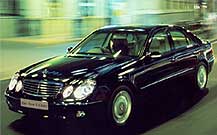Daimler launches Mercedes E-class petrol, diesal variants in India
20 January 2006
 Mumbai: DaimlerChrysler India has announced the launch of the E-280, its new variant of the new Mercedes-Benz E-class in India. The company has also announced debut of the diesel variant, the E-280CDI in India.
Mumbai: DaimlerChrysler India has announced the launch of the E-280, its new variant of the new Mercedes-Benz E-class in India. The company has also announced debut of the diesel variant, the E-280CDI in India.
"Globally, the E-Class remains as one of the most popular models and in India too, this trend finds an echo. In the year 2005, DaimlerChrysler India sold 825 units of the E-class," said Dr. Wilfried Aulbur, MD and CEO of DaimlerChrysler India.
He added, "The new E-280 and the E-280CDI will further strengthen the product-line. The immense appeal of our E-class range in India can, to a large extent, be attributed to the superior aesthetics, performance and power that this vehicle delivers."
The new E-280 (petrol) features trailblazing innovations and has even more enhanced capabilities as compared to its predecessor the E-240. The new E-280 delivers a phenomenal 170kW at 6300 rpm which is an enhancement of over 50 per cent as compared to its predecessor the E240.
The débutante delivers 282 Nm at 2500 - 5000 rpm as compared to 225 Nm at 4500 rpm for the E-240. In addition are features like parametric steering that enhances steering comfort, the new V-6 engines, 7-speed automatic transmission, electrohydraulic braking system. The new E-280 shows its dynamic character with outstanding agility, sports car like handling and superb
cornering and at the same time the exceptional braking system ensures maximum handling safety and help the driver to cope better with emergency situations.
Key characteristics that set the new E-280 apart from its predecessors include higher torque, smooth power delivery, reduced fuel consumption, enhanced refinement and lower noise emissions. The increase in power and torque is largely due to the following technical advancements namely 4-valve technology with continuous intake and exhaust camshaft adjustment, optimisers of all air ducting components, intake ports in conjunction with adjustable tumble flaps for each intake port, combustion optimisation, a further reduction in friction losses, improved thermal management in the coolant circuit and optimised oil and water pump drives.
